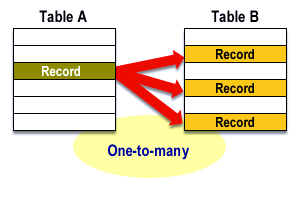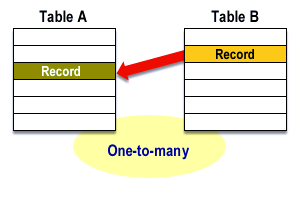| Lesson 6 | One-to-many relationships, part 1 |
| Objective | Define one-to-many Relationships |
One-to-many Relationships
A one-to-many (1:N) relationship exists when
To illustrate such a relationship graphically, think of entities A and B in terms of generic tables. A one-to-many relationship exists when one record in Table A can be associated with many records in Table B, and one record in Table B can be associated with one record in Table A. The following series of images illustrates a 1:N relationship between Tables A and B from the viewpoint first of Table A, then of Table B.
- for one instance of entity A, there exists zero, one, or many instances of entity B;
- but for one instance of entity B, there exists zero or one instance of entity A.
To illustrate such a relationship graphically, think of entities A and B in terms of generic tables. A one-to-many relationship exists when one record in Table A can be associated with many records in Table B, and one record in Table B can be associated with one record in Table A. The following series of images illustrates a 1:N relationship between Tables A and B from the viewpoint first of Table A, then of Table B.


Real world Examples of one to many Relationships in Data Modeling
Data modeling is the process of creating a conceptual representation of data and defining the relationships between different data elements. One-to-many relationships are an essential part of data modeling, where one entity is associated with multiple related entities. In this article, we will discuss some real-world examples of one-to-many relationships and how they are used in various applications.
Real-World Applications of One-to-Many Relationships
- Customer and Orders: One of the most common examples of a one-to-many relationship in data modeling is the relationship between customers and their orders. In this scenario, a customer can place multiple orders, but each order is associated with only one customer. This relationship is established by creating a foreign key in the orders table that references the primary key in the customers table.
- Blog Posts and Comments: Another example of a one-to-many relationship in data modeling is the relationship between blog posts and their comments. A blog post can have multiple comments, but each comment is associated with only one blog post. This relationship is established by creating a foreign key in the comments table that references the primary key in the blog posts table.
- Authors and Books: A third example of a one-to-many relationship in data modeling is the relationship between authors and their books. In this scenario, an author can write multiple books, but each book is associated with only one author. This relationship is established by creating a foreign key in the books table that references the primary key in the authors table.
- ecommerce Websites: One-to-many relationships are widely used in e-commerce websites to manage customer orders. By creating a one-to-many relationship between customers and their orders, e-commerce websites can efficiently track order histories, process refunds, and manage inventory.
- Social Media Platforms: Social media platforms use one-to-many relationships extensively to manage user-generated content. For instance, a user can create multiple posts, but each post is associated with only one user. This relationship allows social media platforms to maintain content authenticity, ensure data privacy, and offer personalized experiences to their users.
- Library Management Systems: Library management systems use one-to-many relationships to manage authors and their books. By creating a one-to-many relationship between authors and books, library management systems can efficiently manage book collections, track book loans, and maintain author profiles.
One-to-many relationships offer several benefits in data modeling, including:
In conclusion, one-to-many relationships are an essential part of data modeling and offer several benefits in real-world applications. By understanding the concept of one-to-many relationships and their applications, businesses can create efficient and scalable data models that can help drive business growth and success. We hope this article has been informative and useful in helping you understand the importance of one-to-many relationships in data modeling. By using the examples provided and applying the benefits of one-to-many relationships, businesses can optimize their data models and gain a competitive advantage in their respective industries.
- Improved Data Integrity:One-to-many relationships ensure data integrity by preventing duplicate data and ensuring that each data element is associated with only one related entity. This helps maintain accurate and consistent data across different applications.
- Efficient Data Management: One-to-many relationships enable efficient data management by allowing data to be organized in a structured and hierarchical manner. This helps simplify complex data models and enables easy retrieval and processing of data.
- Scalability:One-to-many relationships enable scalability by allowing data to be expanded and modified easily without affecting other related data elements. This helps ensure that data models remain flexible and adaptable to changing business needs.
In conclusion, one-to-many relationships are an essential part of data modeling and offer several benefits in real-world applications. By understanding the concept of one-to-many relationships and their applications, businesses can create efficient and scalable data models that can help drive business growth and success. We hope this article has been informative and useful in helping you understand the importance of one-to-many relationships in data modeling. By using the examples provided and applying the benefits of one-to-many relationships, businesses can optimize their data models and gain a competitive advantage in their respective industries.
Questions to ask yourself when dealing with two Entities
When you have two entities ask yourself these questions.
one-to-many (1:N) Relationships
- How many entities of B can belong to entity A?
- How many entities of A can belong to entity B?
A one-to-many (1:N) relationships is when for one instance of entity A, there are zero, one, or many instances of entity B, but for one instance of entity B, there is only one instance of entity A.
An example of a 1:N relationships is
An example of a 1:N relationships is
a department has many employees
each employee is assigned to one department
Ad Database Design and Theory
One-to-Many Relationships
The most common type of relationship is a one-to-many relationship. In fact, most relational databases are constructed from the rare one-to-one relationship and numerous one-to-many relationships. For example, DistributedNetworks typically orders many titles from each distributor, and a given title comes from only one distributor. By the same token, a customer places many orders, but an order comes from only one customer. If we have instances of two entities (A and B), then a one-to-many relationship exists between two instances (Ai and Bi) if Ai is related to zero, one, or more instances of entity B and Bi is related to zero or one instance of entity A. Other one-to-many relationships include that between a daughter and her biological mother.
A woman may have zero, one, or more biological daughters; a daughter can have only one biological mother. As another example, consider a computer and its CPU. A CPU may not be installed in any computer, or it may be installed in at most one computer. A computer may have no CPU, one CPU, or more than one CPU.
Our previous example of DistributedNetworks and the distributor from which it ordered only one title is actually a one-to-many relationship where the 'many' is currently 'one'. Remember that when we are specifying data relationships, we are indicating possible relationships and not necessarily requiring that all instances of all entities participate in every documented relationship. There is absolutely no requirement that a distributor be related to any merchandise item, much less one or more merchandise items. (It might not make much sense to have a distributor in the database from which the company does not order, but there is nothing to prevent data about that distributor from being stored.)
The next lesson explores one-to-many relationships further.
Our previous example of DistributedNetworks and the distributor from which it ordered only one title is actually a one-to-many relationship where the 'many' is currently 'one'. Remember that when we are specifying data relationships, we are indicating possible relationships and not necessarily requiring that all instances of all entities participate in every documented relationship. There is absolutely no requirement that a distributor be related to any merchandise item, much less one or more merchandise items. (It might not make much sense to have a distributor in the database from which the company does not order, but there is nothing to prevent data about that distributor from being stored.)
The next lesson explores one-to-many relationships further.